Page 43 of 268
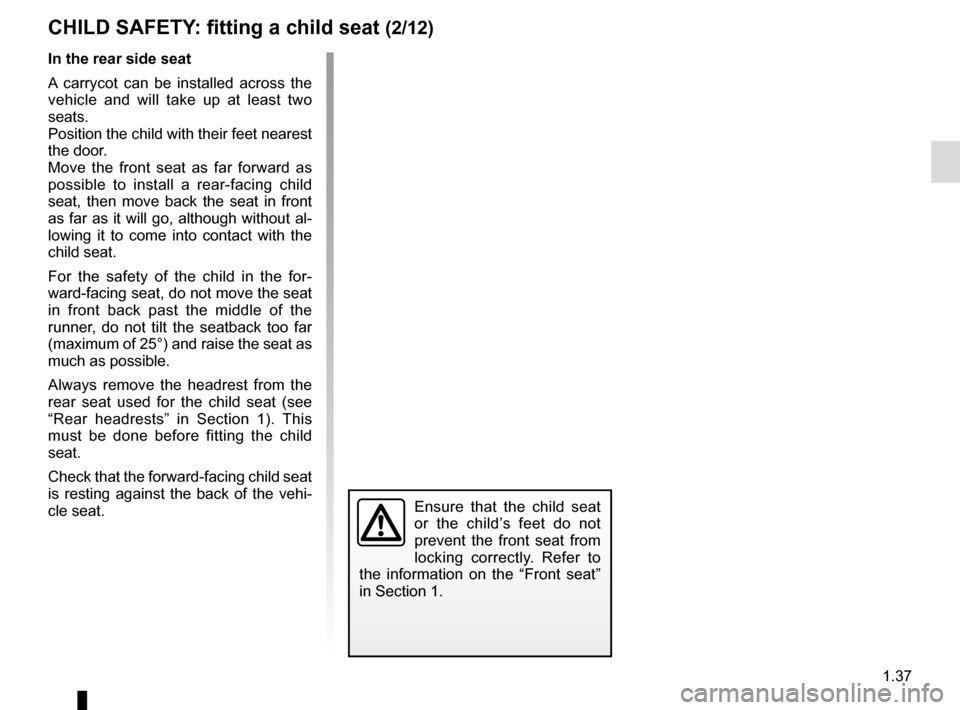
1.37
Ensure that the child seat
or the child’s feet do not
prevent the front seat from
locking correctly. Refer to
the information on the “Front seat”
in Section 1.
In the rear side seat
A carrycot can be installed across the
vehicle and will take up at least two
seats.
Position the child with their feet nearest
the door.
Move the front seat as far forward as
possible to install a rear-facing child
seat, then move back the seat in front
as far as it will go, although without al-
lowing it to come into contact with the
child seat.
For the safety of the child in the for-
ward-facing seat, do not move the seat
in front back past the middle of the
runner, do not tilt the seatback too far
(maximum of 25°) and raise the seat as
much as possible.
Always remove the headrest from the
rear seat used for the child seat (see
“Rear headrests” in Section 1). This
must be done before fitting the child
seat.
Check that the forward-facing child seat
is resting against the back of the vehi-
cle seat.
CHILD SAFETY: fitting a child seat (2/12)
Page 44 of 268
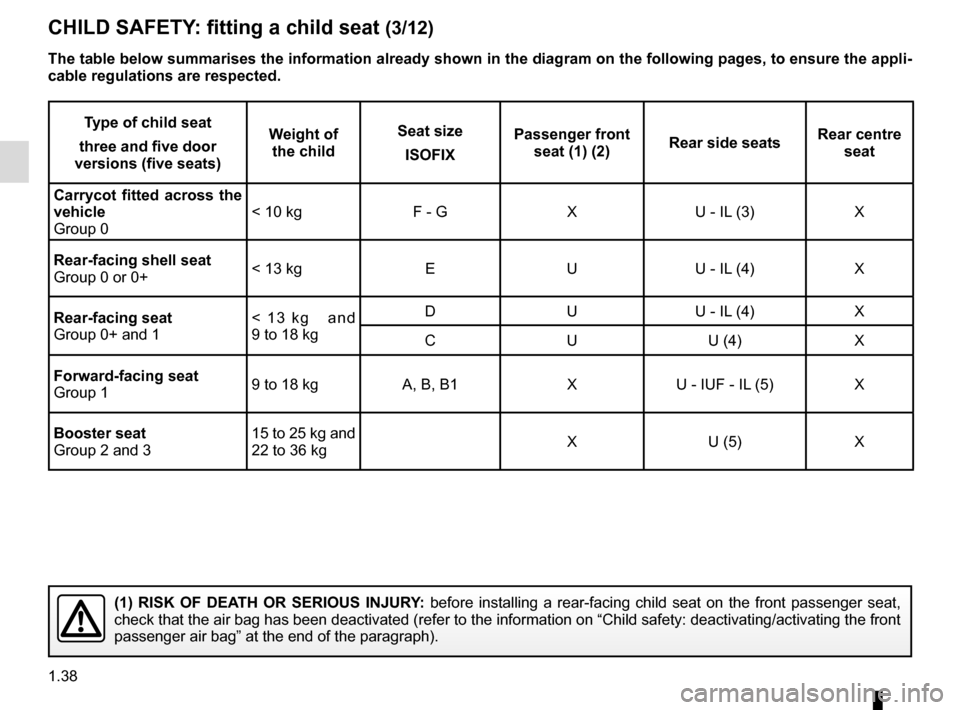
1.38
CHILD SAFETY: fitting a child seat (3/12)
Type of child seat
three and five door
versions (five seats) Weight of
the child Seat size
ISOFIX Passenger front
seat (1) (2) Rear side seats Rear centre
seat
Carrycot fitted across the
vehicle
Group 0 < 10 kg F - G X U - IL (3) X
Rear-facing shell seat
Group 0 or 0+ < 13 kg E U U - IL (4) X
Rear-facing seat
Group 0+ and 1 < 13 kg and
9 to 18 kgD U U - IL (4) X
C U U (4) X
Forward-facing seat
Group 1 9 to 18 kg A, B, B1 X U - IUF - IL (5) X
Booster seat
Group 2 and 3 15 to 25 kg and
22 to 36 kg
X U (5) X
(1) RISK OF DEATH OR SERIOUS INJURY: before installing a rear-facing child seat on the front passenger seat,\
check that the air bag has been deactivated (refer to the information o\
n “Child safety: deactivating/activating the front
passenger air bag” at the end of the paragraph).
The table below summarises the information already shown in the diagram \
on the following pages, to ensure the appli-
cable regulations are respected.
Page 45 of 268
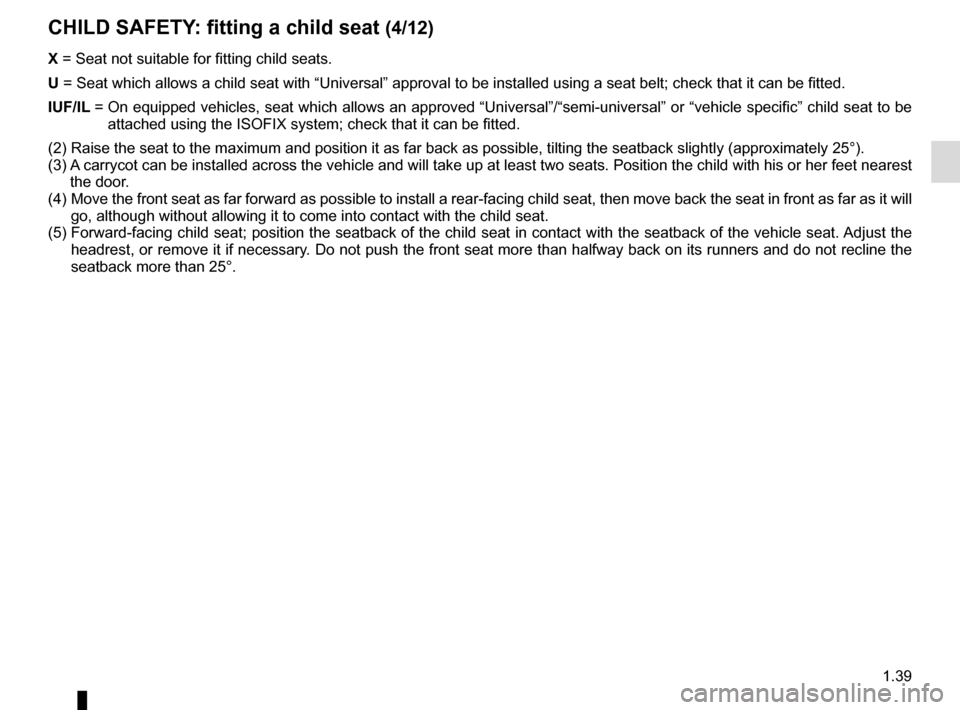
1.39
CHILD SAFETY: fitting a child seat (4/12)
X = Seat not suitable for fitting child seats.
U = Seat which allows a child seat with “Universal” approval to be ins\
talled using a seat belt; check that it can be fitted.
IUF/IL = On equipped vehicles, seat which allows an approved “Universal”/“\
semi-universal” or “vehicle specific” child seat to be
attached using the ISOFIX system; check that it can be fitted.
(2) Raise the seat to the maximum and position it as far back as possible, t\
ilting the seatback slightly (approximately 25°).
(3) A carrycot can be installed across the vehicle and will take up at least \
two seats. Position the child with his or her feet nea rest
the door.
(4) Move the front seat as far forward as possible to install a rear-facing \
child seat, then move back the seat in front as far as it will
go, although without allowing it to come into contact with the child sea\
t.
(5) Forward-facing child seat; position the seatback of the child seat in co\
ntact with the seatback of the vehicle seat. Adjust the
headrest, or remove it if necessary. Do not push the front seat more than halfway back on its runners and d\
o not recline the
seatback more than 25°.
Page 46 of 268
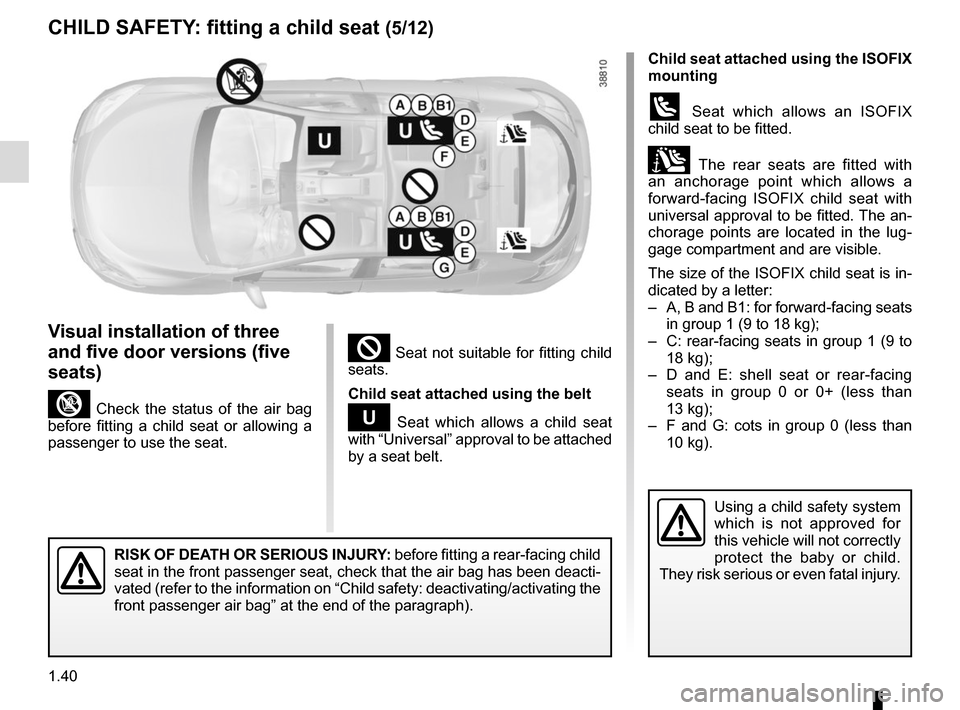
1.40
² Seat not suitable for fitting child
seats.
Child seat attached using the belt
¬ Seat which allows a child seat
with “Universal” approval to be attached
by a seat belt.
RISK OF DEATH OR SERIOUS INJURY: before fitting a rear-facing child
seat in the front passenger seat, check that the air bag has been deacti\
-
vated (refer to the information on “Child safety: deactivating/activ\
ating the
front passenger air bag” at the end of the paragraph).
Child seat attached using the ISOFIX
mounting
ü Seat which allows an ISOFIX
child seat to be fitted.
± The rear seats are fitted with
an anchorage point which allows a
forward-facing ISOFIX child seat with
universal approval to be fitted. The an-
chorage points are located in the lug-
gage compartment and are visible.
The size of the ISOFIX child seat is in-
dicated by a letter:
– A, B and B1: for forward-facing seats in group 1 (9 to 18 kg);
– C: rear-facing seats in group 1 (9 to 18 kg);
– D and E: shell seat or rear-facing seats in group 0 or 0+ (less than
13 kg);
– F and G: cots in group 0 (less than 10 kg).
CHILD SAFETY: fitting a child seat (5/12)
Using a child safety system
which is not approved for
this vehicle will not correctly
protect the baby or child.
They risk serious or even fatal injury.
Visual installation of three
and five door versions (five
seats)
³ Check the status of the air bag
before fitting a child seat or allowing a
passenger to use the seat.
Page 47 of 268

1.41
² Seat not suitable for fitting child
seats.
Child seat attached using the belt
¬ Seat which allows a child seat
with “Universal” approval to be attached
by a seat belt.
RISK OF DEATH OR SERIOUS INJURY: before fitting a rear-facing child
seat in the front passenger seat, check that the air bag has been deacti\
-
vated (refer to the information on “Child safety: deactivating/activ\
ating the
front passenger air bag” at the end of the paragraph).
Child seat attached using the ISOFIX
mounting
ü Seat which allows an ISOFIX
child seat to be fitted.
± The rear seats are fitted with
an anchorage point which allows a
forward-facing ISOFIX child seat with
universal approval to be fitted. The an-
chorage points are located in the lug-
gage compartment and are visible.
The size of the ISOFIX child seat is in-
dicated by a letter:
– A, B and B1: for forward-facing seats in group 1 (9 to 18 kg);
– C: rear-facing seats in group 1 (9 to 18 kg);
– D and E: shell seat or rear-facing seats in group 0 or 0+ (less than
13 kg);
– F and G: cots in group 0 (less than 10 kg).
CHILD SAFETY: fitting a child seat (6/12)
Using a child safety system
which is not approved for
this vehicle will not correctly
protect the baby or child.
They risk serious or even fatal injury.
Visual installation of five
door versions (four seats)
³ Check the status of the air bag
before fitting a child seat or allowing a
passenger to use the seat.
Page 48 of 268
1.42
CHILD SAFETY: fitting a child seat (7/12)
Type of child seatfive door version (four seats) Weight of
the child Seat size
ISOFIX Passenger front
seat (1) (2) Rear side seats
Carrycot fitted across the
vehicle
Group 0 < 10 kg F - G X U - IL (3)
Rear-facing shell seat
Group 0 or 0+ < 13 kg
EUU - IL (4)
Rear-facing seat
Group 0+ and 1 < 13 kg and
9 to 18 kgD
UU - IL (4)
C UU (4)
Forward-facing seat
Group 1 9 to 18 kg
A, B, B1 XU - IUF - IL (5)
Booster seat
Group 2 and 3 15 to 25 kg and
22 to 36 kg
X
U (5)
(1) RISK OF DEATH OR SERIOUS INJURY: before installing a rear-facing child seat on the front passenger seat,\
check that the air bag has been deactivated (refer to the information o\
n “Child safety: deactivating/activating the front
passenger air bag” at the end of the paragraph).
The table below summarises the information already shown on the diagram \
on the previous page, to ensure the regula-
tions in force are respected.
Page 49 of 268
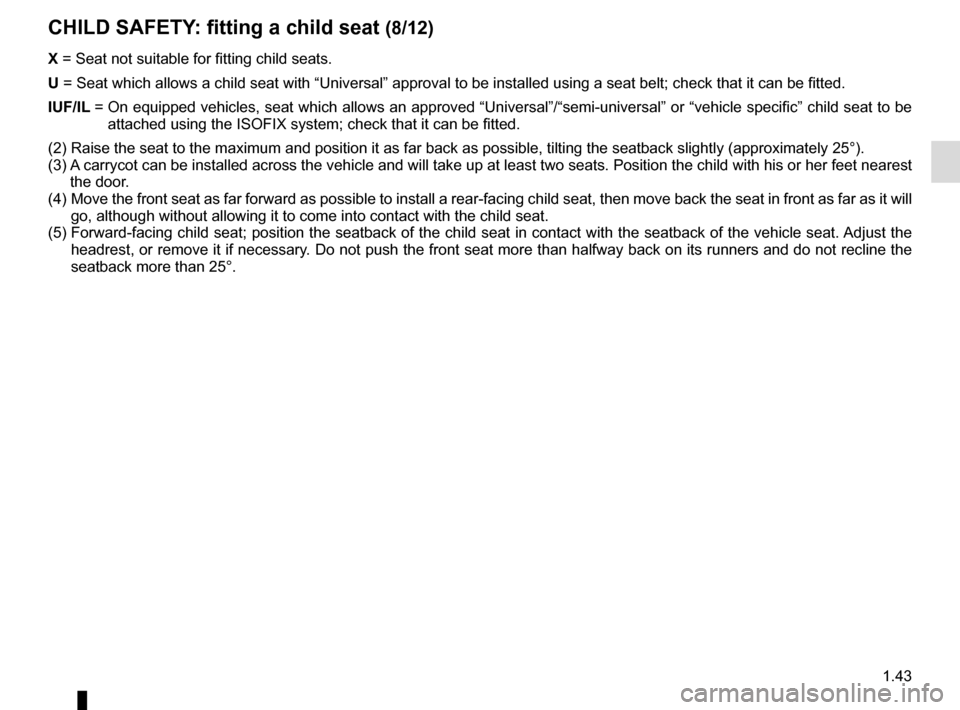
1.43
X = Seat not suitable for fitting child seats.
U = Seat which allows a child seat with “Universal” approval to be ins\
talled using a seat belt; check that it can be fitted.
IUF/IL = On equipped vehicles, seat which allows an approved “Universal”/“\
semi-universal” or “vehicle specific” child seat to be
attached using the ISOFIX system; check that it can be fitted.
(2) Raise the seat to the maximum and position it as far back as possible, t\
ilting the seatback slightly (approximately 25°).
(3) A carrycot can be installed across the vehicle and will take up at least \
two seats. Position the child with his or her feet nea rest
the door.
(4) Move the front seat as far forward as possible to install a rear-facing \
child seat, then move back the seat in front as far as it will
go, although without allowing it to come into contact with the child sea\
t.
(5) Forward-facing child seat; position the seatback of the child seat in co\
ntact with the seatback of the vehicle seat. Adjust the
headrest, or remove it if necessary. Do not push the front seat more than halfway back on its runners and d\
o not recline the
seatback more than 25°.
CHILD SAFETY: fitting a child seat (8/12)
Page 50 of 268
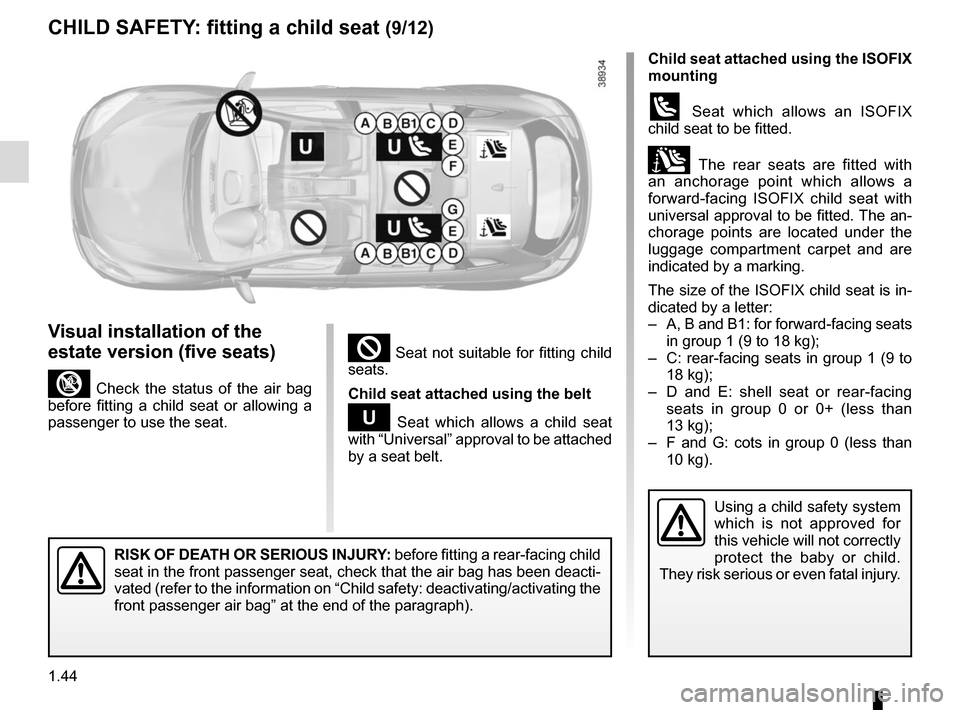
1.44
² Seat not suitable for fitting child
seats.
Child seat attached using the belt
¬ Seat which allows a child seat
with “Universal” approval to be attached
by a seat belt.
Child seat attached using the ISOFIX
mounting
ü Seat which allows an ISOFIX
child seat to be fitted.
± The rear seats are fitted with
an anchorage point which allows a
forward-facing ISOFIX child seat with
universal approval to be fitted. The an-
chorage points are located under the
luggage compartment carpet and are
indicated by a marking.
The size of the ISOFIX child seat is in-
dicated by a letter:
– A, B and B1: for forward-facing seats in group 1 (9 to 18 kg);
– C: rear-facing seats in group 1 (9 to 18 kg);
– D and E: shell seat or rear-facing seats in group 0 or 0+ (less than
13 kg);
– F and G: cots in group 0 (less than 10 kg).
CHILD SAFETY: fitting a child seat (9/12)
Using a child safety system
which is not approved for
this vehicle will not correctly
protect the baby or child.
They risk serious or even fatal injury.
Visual installation of the
estate version (five seats)
³ Check the status of the air bag
before fitting a child seat or allowing a
passenger to use the seat.
RISK OF DEATH OR SERIOUS INJURY: before fitting a rear-facing child
seat in the front passenger seat, check that the air bag has been deacti\
-
vated (refer to the information on “Child safety: deactivating/activ\
ating the
front passenger air bag” at the end of the paragraph).